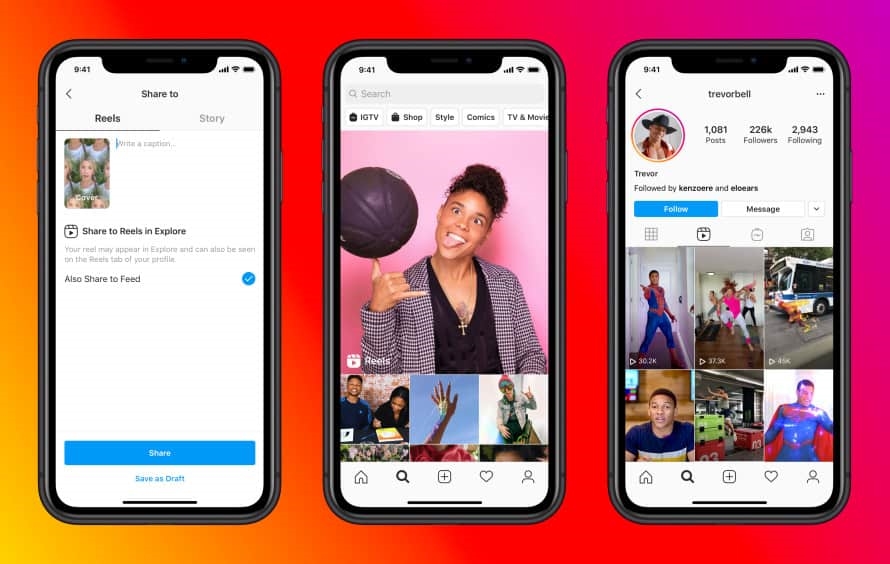Facebook Launches Instagram Reels to Battle TikTok: What It Means For Brands
In case you’ve been blissfully away from a social media news source recently, on 5 August Facebook launched Instagram Reels.
I’m going to walk through some of the ‘how we got here’ aspects first.
A lot of this article is also about the consumer aspect of social networks, but I’m tying in the brand aspect toward the end.
As social media marketers, it’s important to understand the consumer culture angle of the ebb and flow of the different platforms, as this should drive how you approach each as a brand.
If you are already familiar with Reels and TikTok and want to skip to the content about what it all means for brands, use our table of contents:
What are Instagram Reels and TikTok anyway
TikTok’s background
TikTok was first launched as ‘Douyin’ in China in September 2016. In 2017, ByteDance (the developer) launched ‘TikTok’ in non-mainland China markets, although it didn’t really take off until after the emerging service was launched with Musical.ly (who ByteDance acquired) in August 2018.
TikTok’s main features are:
- All content is video with audio
- The audio is most commonly a segment of a music track (but might also include voice overs or other sounds)
- Initially content needed to be 15 seconds long, but that was later extended to 60 seconds
- Users browse TikToks through the ‘For You’ feed (known as the ‘for you page’ or FYP), which is a totally algorithmically-driven infinitely-long feed of TikToks
- Users can like, comment and share videos (including sharing to other social networks)
- Users can follow their favourite TikTok creators and see a (separate) feed of just accounts that they follow
TikTok was (IMHO) born out of the ashes that was Vine (#RIP), which was a similar short-form (6-7 seconds) video service launched in 2012 but shut down in 2016, however users browsed Vine more like they do Instagram than having the ‘For you page’.
TikTok’s big innovation on Vine was adding the ability to sync tracks to music, which opened many doors for various creative endeavours.
Further, the ‘for you page’ allowed users to get a gigantic volume of organic discovery, where users would come across the account
Much like Vine and others before it, much of TikTok’s most popular content is either specific ‘dances’ to a particular music track, or emotionally-driven content (funny/sad/scary/…). Many of the now-popular YouTube influencers had their start on Vine.
Here’s an example of a ‘dance’ from @charlidamelio, who is the most followed TikTok account (she grew much of her following from dances like this, which are then ‘duetted’ by others):
@charlidamelio be happy music video out now link in bio dc @haleygilchrist_ 💕💕
If you haven’t seen TikTok before, check out our roundup of 10 cat TikToks that made us laugh.
TikTok is not without controversy though. Wired’s cover story for their September issue highlighted that TikTok has driven what they described as ‘the evolution of digital blackface‘.
Additionally (discussed a bit later), the fact that TikTok is owned and operated by a Chinese company has caused bans in India, and currently it’s looking like they will be forced to sell their non-mainland China operations to a US company (Microsoft is the front-runner).
In comes Instagram and Facebook
Facebook uh … keeps an eye on other social networks, as you might expect. We all remember that ‘stories’ as a format started with Snapchat and were shamelessly copied to Instagram (then Facebook – admittedly LinkedIn is not lacking in blame here too).
Hello ma friend pic.twitter.com/b3pRwmjfnr
— Goblog Otodidak (@alfonsus73) August 5, 2020
Facebook needed an answer to TikTok, and that answer was “Reels”. It was originally launched in November 2019 in Brazil.
It’s now become “Instagram Reels”, and the format is integrated into Instagram proper.
Reels was launched in most countries 5 August. Here’s the video they shared at launch:
Like TikTok, it has a 15 second limit, and is designed around sharing videos synced to music tracks.
Users browse Reels through a custom version of the ‘explore page’, and Instagram has introduced a similar style of algorithm (presumably combining accounts that you follow as well as trending (they call them ‘featured’) videos, with featured videos curated by Instagram staff) to allow you to scroll infinitely (middle image below). You can see all of the reels made by a user on their profile page in a new tab/section (next to IGTV – see the right hand image below).
Users can also see Reels in their normal Instagram feed (left hand image above), and can choose whether to post just to the Explore feed or also to their main Instagram feed. You can also share Reels to your Instagram story or DM them to someone.

Image via Facebook’s announcement
Differences between Reels and TikTok
As journalist Joanna Stern highlighted, some aspects of Reels are clearly ripped off one-for-one, like the layout of Reels’ view count and ‘play button’:
Instagram Reels or TikTok? Can you spot the difference? pic.twitter.com/Crt8e5sh6B
— Joanna Stern (@JoannaStern) August 5, 2020
Mark Zuckerberg has remarked before when Instagram copied the stories format from Snapchat that they are not worried about copying features that they think are great.
You certainly look at the two products next to each other, knowing that Reels has probably been in the works for at least a year now, and do this:


Underlying platform culture
The culture of a particular social network is a really important determinant to who uses it and the type of content that performs well. It’s not just the format (story vs profile vs Reel/TikTok), but the underlying ‘style’ and what people expect when they use that social network.
To understand more about this cultural aspect, follow the work of journalist Taylor Lorenz or academics like Danah Boyd. Boyd is a fantastic expert in the space of ‘ethnography’ (study of culture) and how it relates to younger generations’ use of social networks – her PhD dissertation is fascinating reading if you really want to nerd out, but I also recommend her book on the subject. Data and Society, founded by Boyd, is also a great and under-rated news source.
TikTok’s culture is evidently one centred around the For You Page, and the concept of organic discovery of content. It doesn’t matter (as) much how many followers you have, more so the number of views your TikToks get.
This really incentivises engagement across different accounts, and because it’s less ‘profile-centric’, successful TikTok users will often create a large volume of content to see what resonates.
TikTok’s culture is in its early days – the earlier article about ‘digital blackface‘ a good example of how expectations and norms are still in development.
Eugene Wei has written a fantastic piece on TikTok and what he calls “cultural abstraction”. You should definitely read it. I’m looking forward to his later posts in the series about TikTok.
Instagram is clearly quite different, and comes with a long history and culture.
Stories introduced more of an ephemeral ‘vibe’, but Instagram for consumers is still very heavily tied to their individual brand and personality. Due to having lots of followers who they know in the real world on Instagram (and knowing sharing Instagram account usernames is often a way to find out more about someone met on a dating app for example), content can often be less ‘open’.
Instagram has been trying for some time to deliver both a ‘professional public face’ and a ‘friend network’ vibe with features like ‘close friends’ to restrict where stories (as the more ephemeral format) are distributed while still encouraging users to allow anyone to follow them.
It is yet to be seen how Reels changes the cultural dynamic of Instagram. I am sure that within existing influencers, we’ll see them quickly test the new format and see what happens.
I’m more interested long term with how Reels changes (or not) the underlying Instagram culture. Stories was definitely a resounding success in adding a more casual/ephemeral layer of communication to Instagram.
Ads
TikTok has ads, which appear interspersed while scrolling through the For You Page (much like how Instagram stories ads appear as you ‘tap through’ them).
Currently Instagram Reels does not have any advertising, although that’s likely to change in the future if it takes off.
Length of videos
Instagram limits all videos to 15 seconds (currently) while TikTok allows users to string together up to 4 videos, essentially allowing 60 seconds of content per post.
Public vs (potentially) private
TikTok is essentially all public content (while it’s possible to create private accounts, this is less common as videos won’t appear on the For You page, so you don’t get that organic discovery), while Instagram Reels includes the overlay of whether the ‘parent’ Instagram account is public or private.
From the Instagram FAQs on Reels:
Who can see and share my reels?
Who can see and share your reels follows your account’s privacy settings:
– For public accounts: Anyone on Instagram can see and share your reels. People may see your reels on Explore and places like effect, hashtag and audio pages. Anyone on Instagram can create a reel using your original audio.
– For private accounts: Only your approved followers can see and share your reels. When someone shares your reel, only your followers will be able to see it. No one will be able to create a reel using your original audio.Keep in mind, reels you post to Feed or Explore will appear in the Reels tab on your Instagram profile. Reels shared to Stories and Direct will disappear in 24 hours and won’t appear on your profile.
Will Reels or TikTok win the battle? What is the war?
This is a really great question, and the jury is very much still out as to whether Reels will gain mass traction. If Instagram Stories are anything to go by, TikTok may be in trouble.
This is doubly so if President Trump (or another nation) decides to ‘ban’ TikTok (India already has!). Even a divestment of TikTok’s operations in the US, Canada, New Zealand and Australia will be a huge distraction, and Microsoft is not necessarily the company you associate with younger audiences (Yammer anyone? Let’s have a YamJam).
However, Microsoft’s acquisition of LinkedIn shows that it is possible for them to be mostly hands-off with an acquisition.
So there is a battle going on in the short term, which may well cause TikTok enough distraction to lose the lead. Similarly, Instagram may (as happened with stories and Snapchat) successfully stop people deciding to go and play with TikTok, which will hamper growth efforts. Of course, Snapchat isn’t dead – they have 238 million daily active users and grew well in quarter 2 of 2020 (mostly outside the US) – but they did not end up the ‘Facebook killer’ some pundits suggested (hoped?) they would be.
But I keep coming back to this question of culture, and I think that’s where things might get unstuck for Reels.
The challenge Instagram has is shifting the culture from public (feed) and casual/ephemeral (stories) into this sense of almost what I’d call ‘structured fun’ (e.g. the viral dances to a certain track).
It is no small thing to change the culture of a social network part of the ‘big blue network’ with 3.14 billion people across all of Facebook’s apps (they don’t break down the monthly active users for Instagram yet).
The benefit they have is that some of the playbook of what will likely be successful is already written – I can see content that performs well on TikTok also performing well on Instagram (this kind of emotion-driven content, particularly for ‘funny’). Much of the content currently doing well on Reels seems to be TikToks that have been cross-posted to Reels.
We will also see how many influencers move from one platform to another.
The potential ban of TikTok has once again reminded that community of the risks of being beholden to a single social network for distribution – influencers are now much more savvy about trying to drive followers to follow them everywhere (e.g. from TikTok to their Instagram or YouTube).
How brands should think about emerging platforms like TikTok and Reels
Okay so that’s all great for the consumer aspect of this war. What does it means for brands?
I think that you need to meet three things to really look at having a presence on TikTok or Reels:
- the ability to generate customised video content of an appropriate length and style,
- an understanding of the shifting and changing culture of the channel, and
- the capability to jump on emerging trends without lengthy production or approval cycles.
What won’t work (but will be attempted!) will be just lazily slamming video content from one place to the next. Jonathan recently wrote about this ‘create once, post everywhere’ (COPE) strategy and the pitfalls.
That cultural understanding is really important to success, and there is nothing worse than the cringe of seeing content clearly designed to be a Facebook ad just slammed into TikTok as if it’s the same thing.
Similarly, brands with long approval cycles and complex branding environments are unlikely to perform well, as by the time a piece of content is specced/shot/produced, the trend is over.
Categorising your social media channels
As a consultant, one of the main activities that I worked through with some clients who had ‘channel sprawl’ (tons of accounts across different social networks, many of which were dormant/mostly unused) was working out where each channel sits.
You can think of your social networks as going into one of four categories:
- Core channels, where you have an active presence, posting and engaging regularly. These channels are where you actively ‘push’ customers toward.
- Satellite channels, where you have a presence that you keep an eye on, and maybe post from time to time, but it’s not really important.
- Experimental channels, where you’re seeing if something works for the brand, but it’s often one person on the team ‘playing around’ to see what sticks rather than any kind of focus.
- Ignored channels, where you have chosen not to engage on the platform at all (you might have registered an account to stop someone name-squatting, but you’re not really “there”).
It goes without saying that most effort and attention should be spent on core channels.
What I think a lot of people get wrong is thinking that every channel is a core channel. It is totally okay to call something a satellite channel and not really pay (as) much attention to it. You need to – there are only so many hours in a day.
Additionally, your brand will work well in some places and poorly in others. There is no use beating a dead horse – if your audience doesn’t want to follow you in a particular place (for whatever reason!), you aren’t going to suddenly make them do so.
Finally, some channels should just be ignored. You don’t need a Google+ or MySpace profile (even if they weren’t shut down!).
TikTok or Reels might be seen as an experimental channel in the short term, or you might put it in your ‘ignored’ bucket as more of a wait-and-see approach.
One challenge with experimental channels is that they can feel in the shorter term like a waste of time, because you have to spend a lot of time understanding the culture and identifying what works or doesn’t before really seeing much success.
However you need to be explicit about the role of each channel.
You’re always a lot better to do few things (channels) well than many things poorly, and it is remarkably easy to spread yourself too thin.
Digital & Social Articles on Business 2 Community
(41)


